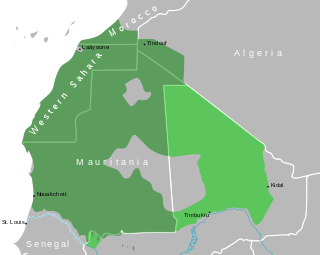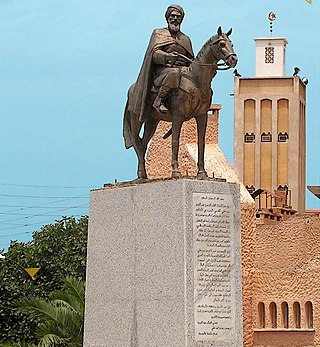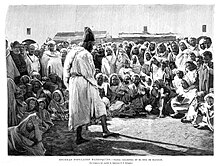
The Bedouin, Beduin, or Bedu are pastorally nomadic Arab tribes who have historically inhabited the desert regions in the Arabian Peninsula, North Africa, the Levant, and Mesopotamia (Iraq). The Bedouin originated in the Syrian Desert and Arabian Desert but spread across the rest of the Arab world in West Asia and North Africa after the spread of Islam. The English word bedouin comes from the Arabic badawī, which means "desert-dweller", and is traditionally contrasted with ḥāḍir, the term for sedentary people. Bedouin territory stretches from the vast deserts of North Africa to the rocky ones of the Middle East. They are sometimes traditionally divided into tribes, or clans, and historically share a common culture of herding camels, sheep and goats. The vast majority of Bedouins adhere to Islam, although there are some fewer numbers of Christian Bedouins present in the Fertile Crescent.

Beni Ḥassan is a Bedouin Arab tribe which inhabits Western Sahara, Mauritania, Morocco and Algeria. It is one of the four sub-tribes of the Banu Maqil who emigrated in the 11th century from South Arabia to the Maghreb with the Banu Hilal and Banu Sulaym Arab tribes. In the 13th century, they took the Sanhaja territories in the southwest of the Sahara. In Morocco, they first settled, alongside their Maqil relatives, in the area between Tadla and the Moulouya River. The Sous Almohad governor called upon them for help against a rebellion in the Sous, and they resettled in and around that region. They later moved to what is today Mauritania, and from the 16th century onwards, they managed to push back all black peoples southwards to the Senegal Valley river. The Beni Hassan and other warrior Arab tribes dominated the Sanhaja Berber tribes of the area after the Char Bouba war of the 17th century. As a result, Arabs became the dominant ethnic group in Western Sahara and Mauretania. The Bani Hassan dialect of Arabic became used in the region and is still spoken, in the form of Hassaniya Arabic. The hierarchy established by the Beni Hassan tribe gave Mauritania much of its sociological character. That ideology has led to oppression, discrimination and even enslavement of other groups in Mauritania.

The Banu Hilal was a confederation of Arab tribes from the Najd region of the central Arabian Peninsula that emigrated to the Maghreb region of North Africa in the 11th century. Masters of the vast plateaux of the Najd, they enjoyed a somewhat infamous reputation, possibly owing to their relatively late conversion to Islam and accounts of their campaigns in the borderlands between Iraq and Syria. When the Fatimid Caliphate became the rulers of Egypt and the founders of Cairo in 969, they hastened to confine the unruly Bedouin in the south before sending them to Central North Africa and then to Morocco.

Abd al-Mu'min was a prominent member of the Almohad movement. Although the Almohad movement itself was founded by Ibn Tumart, Abd al-Mu'min was the founder of the ruling dynasty and creator of the Almohad empire. As a leader of the Almohad movement he became the first Caliph of the Almohad Empire in 1133, after the death in 1130 of the movement's founder, Ibn Tumart, and ruled until his death in 1163. Abd al-Mu'min put his predecessor's doctrine of Almohadism into practice, defeated the Almoravids, and extended his rule across Al-Andalus and as far as Tunis in Ifriqiya, thus bringing the Maghreb in North Africa and Al-Andalus in Europe under one creed and one government.

Abu Abd Allah Amghar Ibn Tumart was a Muslim Berber religious scholar, teacher and political leader, from the Sous in southern Morocco. He founded and served as the spiritual and first military leader of the Almohad movement, a puritanical reform movement launched among the Masmuda Berbers of the Atlas Mountains. Ibn Tumart launched an open revolt against the ruling Almoravids during the 1120s. After his death his followers, the Almohads, went on to conquer much of North Africa and part of Spain. Although the Almohad movement itself was founded by Ibn Tumart, his disciple Abd al-Mu'min was the founder of the ruling dynasty and creator of the Almohad empire.
The Masmuda is a Berber tribal confederation of Morocco and one of the largest in the Maghreb, along with the Zenata and the Sanhaja. Today, the Masmuda confederacy largely corresponds to the speakers of the Shilha (Tachelhit) Berber variety, whereas other clans, such as Regraga have adopted Arabic.
Shara'b Ar Rawnah District is a district of the Taiz Governorate, Yemen. As of 2003, the district had a population of 186,955 inhabitants.

Sharʿab as-Salam District is a district of the Taiz Governorate, Yemen. In 2003, the district had a population of 146,650.
Tashfin ibn Ali was the 6th Almoravid Emir, he reigned in 1143–1145.
Maghrebi Arabs or North African Arabs are the inhabitants of the Maghreb region of North Africa whose ethnic identity is Arab, whose native language is Arabic and trace their ancestry to the tribes of the Arabian Peninsula. This ethnic identity is a product of the centuries-long Arab migration to the Maghreb since the 7th century, which changed the demographic scope of the Maghreb and was a major factor in the ethnic, linguistic and cultural Arabization of the Maghreb region. The descendants of the original Arab settlers who continue to speak Arabic as a first language currently form the single largest population group in North Africa.
Waggag Ibn Zallu al-Lamti was a Moroccan Maliki scholar and jurist who lived in the 11th-century. He was a disciple of Abu Imran al-Fasi and belonged to the Lamta clan, which is a Sanhaja-Berber tribe. Waggag had an eminent role in the rise of the Almoravid Dynasty as he was the religious teacher and spiritual leader of Abdallah ibn Yasin, the founder of the dynasty.
Amr ibn Ma'adi Yakrib al-Zubaīdi al-Madḥ'hijī was an Arabian cavalry commander of the Zubaid clan in Yemen, part of the Madhhij tribe confederation. Amr is considered a legendary warrior, battling against legendary figures like Amir ibn Tufail, Antarah ibn Shaddad and Dorayd bin Al Soma.
Abu Mahammad Abdullah Gamal al-Din bin Yusuf bin Ahmad bin Abdullah bin Hisham al-Ansari al-Masry commonly known as Ibn Hisham Al-Ansari was an Egyptian scholar of Arabic grammar. He is one of the imams of Arabic grammar, more famous than his peers. He was well-informed, well-spoken, righteous and pious. He accompanied Al-Shihab Abd al-Latif ibn al-Marhil and recited to Ibn al-Siraj, and he heard from Abu Hayyan Al-Andalusi the Diwan (collection) of Zuhayr bin Abi Sulma, but he did not stay with him or read to him anything else. He attended the lessons of Taj al-Din al-Tabrizi and read to Taj al-Din al-Fakahani his explanation of the sign, except for the last page. He narrated on Ibn Jama'ah in Shatibiyyah, and he learned to follow the Shafi’i school of thought. Then he converted to the Hanbali school and memorized Mukhtasar al-Kharqi five years before his death. A group of people from Egypt and others produced it and issued it for the benefit of the students. It was unique in providing strange benefits and precise investigations. He had the ability to convey information and make students understand. He was humble, mild-mannered, very compassionate, and tender-hearted.

Kitāb al-ʿIbar is a 14th-century historical encyclopedia in seven volumes written by the Arab sociologist and historian Ibn Khaldun. Its prolegomenon, or introduction, is al-Muqaddima. Kitāb al-ʿIbar was also printed in Arabic under the title Tarīkh Ibn Khaldūn.
Abu al-Hasan Ali bin Abd al-Rahman bin Abi al-Bashaer al-Siqilli, also known as Ibn Abi al-Bishr al-Siqilli, was an Egyptian Arab Sicilian poet of the eleventh century AD / fifth AH, who lived most of his life in Fatimid Egypt.
Aḥmad ibn ʿĪsā ibn Zayd Islamic theologian, Hadith scholar and Faqih, was the grandson of Zayd ibn Ali, one of the famous Alids of the early Abbasid Caliphate and one of the famous Zaydiyyah scholars who lived most of his life on the run. His kunya was Abū ʿAbd Allāh and his nickname was Al-Mukhtafī. His father ʿĪsā Mu'tam al-Ashbal ibn Zayd is considered as the 13th Imām of Zaydiyyā. Ahmad ibn Isa ibn Zayd 's sixty years of secret life is proof of the nickname given to him.

Muhammad Aziz Al-Arfaj is a Saudi writer, poet and journalist.
The Arab migrations to the Maghreb involved successive waves of migration and settlement by Arab people in the Maghreb region of Africa, encompassing modern-day Algeria, Libya, Morocco and Tunisia. The process took place over several centuries, lasting from the early 7th century to the 17th century. The Arab migrants hailed from the Middle East, particularly the Arabian Peninsula, with later groups arriving from the Levant and Iraq.
Abu Kamal Temim bin Ziri bin Ya'la Al-Yafrani, was the leader of the Berber Zenata tribe known as Banu Ifren from 1029 to 1035 during the Middle Ages in the Maghreb. He is the grandson of Yala Ibn Mohammed.
Banu Talis was a Hawwara Dynasty, which appeared in Libya in 1228 and established the city of Bani Walid as its capital.








